This article was influenced by Greg Nathan (www.franchiserelationships.com)
One would think that comparing a franchise organization to a particular type of forest is crazy, but using the Aspen forests of Colorado, USA is a great way to explain the interdependence required between the franchisor and its franchisees.
From above, the forest looks like any other. An orchestra of trees growing next to each other. Each tree in its own right, has a certain beauty, together with hundreds of others, the Aspen forest of trees looks grand and spectacular. Actually, most forests have a similar beauty, but what is different about the Aspen forest is what goes on under the ground in its root system.
In most forests, the many trees are individuals. They develop either by having to be planted separately or they develop via cross pollination. Once the seed is planted, they are left on their own to survive. They cannot feed off one another, help one another nor rely on one another. If one tree gets into trouble, the other trees cannot help besides to just look on while it dies. The Aspen forest however works very differently. Each tree is connected to the other via its root system. 1,000 Aspen trees in one forest all share the same roots. If one tree gets sick, all the trees in the forest will get affected so in order to survive and insure the well being of every tree in the forest, they all need to support one another. Its all about understanding that they are interdependent on each other in order to survive.
Comparing the Aspen forests of Colorado to franchise organizations makes allot of sense. Chances are that if the foundation of the franchise organization is strong and profitable, most of its franchisees will be happy and profitable as well. When I hear of a franchise organization with around 50 locations with only 30 franchisees but with the franchisor owning very few locations, then it means that there are a number of franchisees in the system who own more than one location. This to me is a positive sign that the franchise organization is strong and that its leadership takes their franchisees seriously. At the end of the day, no one franchisee will invest in a second or third location of the same franchise brand if it is weak or does not have potential.
As to why one franchise organization is more successful than another can often be a complex question to analyze. Is it what the brand is selling? Is it because of its great locations? Is it because of its great value for money? Is it because of the great service and customer experience at the location? Probably a little of everything. But one thing is certain, behind every successful franchise location lies a franchisee, and behind every successful franchisee lies his franchisor.
Being the franchisor of a successful brand is not that simple. Typically, the franchisor started the first location many years before and the skills he required to run his first location is very different to the skills he has had to acquire in order to run his team of franchisees. He has had to face untold challenges which may have evolved along the way, where his initial experience as the owner of the first location can no longer help. New challenges are being faced all the time and in most cases, the secret of being a great franchisor is knowing how to analyze and acknowledge the performance of his stronger franchisees and then share his findings with the weaker ones.
Even better, is when the great franchisors build a system of having all his franchisee’s effectively share one another’s best practices in an organized, well orchestrated, and well managed manor. He is the one nourishing and strengthening the root system of his franchise organization so that like the Aspen forest, he will do his utmost to insure that all his franchisees are doing the best they can. In order to achieve this feat, the great franchisor’s understand the power of managing their relationships, creating a franchise relationship culture FOR their franchisees – WITH their franchisees.




